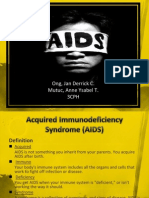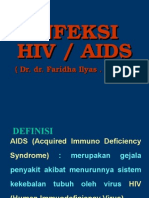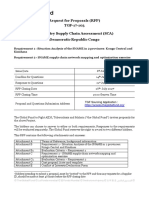100%(1)100% found this document useful (1 vote)
119 viewsHiv/Aids: Dr. Lalu Ahmadi Jaya, SPPD
Hiv/Aids: Dr. Lalu Ahmadi Jaya, SPPD
Uploaded by
Muhammad Bilal Bin AmirThis document provides information about HIV/AIDS, including:
1. It defines AIDS as a collection of symptoms or illnesses caused by the weakening of the immune system due to infection by the HIV virus.
2. The history of HIV/AIDS is summarized, from initial identification of the virus in the 1950s through developments in isolation, testing, and treatment of the virus.
3. Statistics are presented on the global spread of HIV/AIDS and its impact, with over 40 million people estimated to be infected by 2005, especially in sub-Saharan Africa.
Copyright:
© All Rights Reserved
Available Formats
Download as PPT, PDF, TXT or read online from Scribd
Hiv/Aids: Dr. Lalu Ahmadi Jaya, SPPD
Hiv/Aids: Dr. Lalu Ahmadi Jaya, SPPD
Uploaded by
Muhammad Bilal Bin Amir100%(1)100% found this document useful (1 vote)
119 views31 pagesThis document provides information about HIV/AIDS, including:
1. It defines AIDS as a collection of symptoms or illnesses caused by the weakening of the immune system due to infection by the HIV virus.
2. The history of HIV/AIDS is summarized, from initial identification of the virus in the 1950s through developments in isolation, testing, and treatment of the virus.
3. Statistics are presented on the global spread of HIV/AIDS and its impact, with over 40 million people estimated to be infected by 2005, especially in sub-Saharan Africa.
Original Description:
AIDS
Original Title
Aids
Copyright
© © All Rights Reserved
Available Formats
PPT, PDF, TXT or read online from Scribd
Share this document
Did you find this document useful?
Is this content inappropriate?
This document provides information about HIV/AIDS, including:
1. It defines AIDS as a collection of symptoms or illnesses caused by the weakening of the immune system due to infection by the HIV virus.
2. The history of HIV/AIDS is summarized, from initial identification of the virus in the 1950s through developments in isolation, testing, and treatment of the virus.
3. Statistics are presented on the global spread of HIV/AIDS and its impact, with over 40 million people estimated to be infected by 2005, especially in sub-Saharan Africa.
Copyright:
© All Rights Reserved
Available Formats
Download as PPT, PDF, TXT or read online from Scribd
Download as ppt, pdf, or txt
100%(1)100% found this document useful (1 vote)
119 views31 pagesHiv/Aids: Dr. Lalu Ahmadi Jaya, SPPD
Hiv/Aids: Dr. Lalu Ahmadi Jaya, SPPD
Uploaded by
Muhammad Bilal Bin AmirThis document provides information about HIV/AIDS, including:
1. It defines AIDS as a collection of symptoms or illnesses caused by the weakening of the immune system due to infection by the HIV virus.
2. The history of HIV/AIDS is summarized, from initial identification of the virus in the 1950s through developments in isolation, testing, and treatment of the virus.
3. Statistics are presented on the global spread of HIV/AIDS and its impact, with over 40 million people estimated to be infected by 2005, especially in sub-Saharan Africa.
Copyright:
© All Rights Reserved
Available Formats
Download as PPT, PDF, TXT or read online from Scribd
Download as ppt, pdf, or txt
You are on page 1of 31
HIV/AIDS
Dr. Lalu Ahmadi Jaya, SpPD
Definisi
AIDS (Acquired Immunodeficiency
Syndrome)
Kumpulan gejala atau penyakit
Yang disebabkan oleh menurunnya kekebalan tubuh
Akibat infeksi oleh virus HIV (Human
Immunodeficiency Virus)
Acquired Immunodeficiency
Syndrome (AIDS)
History
1950s: Blood samples from Africa have HIV
antibodies.
1976: First known AIDS patient died.
1980: First human retrovirus isolated (HTLV-1).
1981: First reports of Acquired Immuno-
deficiency Syndrome in Los Angeles.
1983: Virus first isolated in France (LAV).
1984: Virus isolated in the U.S. (called HTLV-III
and AIDS-Related Virus, ARV).
1985: Development and implementation of
antibody test to screen blood donors.
Acquired Immunodeficiency
Syndrome (AIDS)
History (Continued)
1986: Consensus name Human Immunodeficiency
Virus (HIV-1).
Related virus (HIV-2) identified.
1992: AIDS becomes the leading cause of death
among adults ages 25-44 in the U.S.
1997: Mortality rates of AIDS starts to decline due
to the introduction of new drug cocktails.
2005: World Health Organization predicts up to
40 million infected individuals. More than 25
million have already died.
AIDS: A Leading Cause of Death Among
People Aged 25-44 years in U.S.
0
5
10
15
20
25
30
35
40
1982 1986 1990 1994
AIDS
Accidents
Cancer
Homicide
Deaths per 100,000 people aged 25-44 years
People Living with HIV/AIDS by End of 2005
North America
950,000
(0.6%)*
Latin America
1.5 million
(0.6%)*
Western Europe
560,000
(0.3%)*
East Europe & Central Asia
1000,000
(0.6%)*
Sub-Saharan Africa
28.5 million
(8.8%)*
North Africa &
Middle East
500,000
(0.3%)*
Australia &
New Zealand
15,000
(0.1%)*
South/South East Asia
5.6 million
(0.6%)*
East Asia & Pacific
1000,000
(0.1%)*
Total: 40 million people
*: Percentage of infected 15-49 year olds per region
Caribbean
420,000
(2.4%)*
The Structure of HIV
Figure 9.19
Structure of the Human Immunodeficiency Virus
HIV is a Retrovirus
CARA PENULARAN
1. Hubungan seksual
2. Kontak langsung dengan darah/produk darah/jarum suntik
3. Secara vertikal
Dari ibu hamil pengidap HIV kepada bayinya
Saat hamil, melahirkan, setelah melahirkan
HIV Lifecycle
1. Attachment
Reverse
Transcriptions
Act Here
2. Entry
3. Transcription
4. Integration
5. Polyprotein
Production
6. Release
7. Maturation
Protein
Inhibitors
Act Here
HIV THE AIDS VIRUS
Manifestasi klinis
Grup I : Infeksi akut
Grup II : Infeksi kronik asimtomatik
Grup III : Pembesaran kelenjar Limfe
Grup IV : Penyakit lain
Sub grup A : Penyakit konstitusional
Sub grup B : Penyakit Neurologis
Sub grup C : Penyakit infeksi sekunder
Sub grup D : Kanker sekunder
Sub grup E : Kondisi-kondisi lainnya
MASA INKUBASI
Masa inkubasi : waktu terjadinya unfeksi
sampai munculnya gejala
Sebagaian besar 5 10 tahun
Variasi sangat lebar mulai 6 bulan
sampai 10 tahun
Stages of HIV Infection
INFEKSI AKUT
Demam
Sakit tenggorok
Batuk
Myalgia
Keringat malam
Keluhan GIT
INFEKSI KRONIK ASIMTOMATIK
Fase akut akan diikuti fase kronik
asimtomatik
Lamanya bisa bertahun-tahun
DIAGNOSIS
Gejala mayor
Penurunan berat badan lebih dari 10%
Diare kronik lebih dari 1 bulan
Demam lebih dari 1 bulan
Gejala minor
Batuk lebih dari 1 bulan
Dermatitis pruritik umum
Herpes zoster recurrens
Kandidiasis orofaring
Limfadenopati generalisata
Herpes simplek diseminata yang kronik progresif
DIAGNOSIS
Pemeriksaan laboratorium
Pembuktian adanya antibody atau antigen HIV
Tes untuk mengetahui antibodi : ELISA, Western Blot, RIPA, IFA
Tes untuk menguji antigen : pembiakan virus, antigen p24 dan PCR
Pemeriksaan status imunitas
Hb, leukosit, trombosit, limfosit
Pemeriksaan terhadap infeksi oportunistik dan keganasan
Laboratorium rutin, serologis, radiologis, USG, CT scan
Antibody Levels, T Cell Counts, and
HIV Concentration After Infection
PENATALAKSANAAN
Virus HIV
Infeksi oportunistik
Kanker sekunder
Status kekebalan tubuh
Simtomatis dan suportif
AIDS Associated Disease Categories
1. Gastrointestinal: Cause most of illness and death
of late AIDS.
Symptoms:
Diarrhea
Wasting (extreme weight loss)
Abdominal pain
Infections of the mouth and esophagus.
Pathogens: Candida albicans, cytomegalovirus,
Microsporidia, and Cryptosporidia.
African AIDS patient with slim disease
Source: Tropical Medicine and Parasitology, 1997
Wasting in an AIDS Patient
Opportunistic Oral Yeast Infection by
Candida albicans in an AIDS Patient
Source: Atlas of Clinical Oral Pathology, 1999
AIDS Associated Disease Categories
2. Respiratory: 70% of AIDS patients develop
serious respiratory problems.
Partial list of respiratory problems associated with AIDS:
Bronchitis
Pneumonia
Tuberculosis
Lung cancer
Sinusitis
Pneumonitis
Chest X-Ray of AIDS Patient with Tuberculosis
AIDS Associated Disease Categories
3. Neurological: Opportunistic diseases and
tumors of central nervous system.
Symptoms many include: Headaches, peripheral
nerve problems, and AI DS dementia complex
(Memory loss, motor problems, difficulty
concentration, and paralysis).
AIDS Associated Disease Categories
4. Skin Disorders: 90% of AIDS patients develop
skin or mucous membrane disorders.
Kaposis sarcoma
1/3 male AIDS patients develop KS
Most common type of cancer in AIDS patients
Herpes zoster (shingles)
Herpes simplex
Thrush
Invasive cervical carcinoma
5. Eye Infections: 50-75% patients develop eye
conditions.
CMV retinitis
Conjunctivitis
Dry eye syndrome
Extensive tumor lesions of Kaposiss sarcoma in AIDS patient.
Source: AIDS, 1997
Chronic Herpes Simplex infection with lesions on tongue and lips.
Source: Atlas of Clinical Oral Pathology, 1999.
Non-Hodgkins Lymphoma & ascites in AIDS patient
Source: Tropical Medicine and Parasitology, 1997
You might also like
- NURS 208 FinalDocument11 pagesNURS 208 FinalCathy PhongNo ratings yet
- Professionalism in NursingDocument4 pagesProfessionalism in NursingSpislgal Philip100% (6)
- Acquired Immunodeficiency Syndrome (HIV Infection, AIDS) : Dr. Rasha SalamaDocument42 pagesAcquired Immunodeficiency Syndrome (HIV Infection, AIDS) : Dr. Rasha SalamamalathiNo ratings yet
- HIV & Acquired Immunodeficiency Syndrome (AIDS) : Dr. YuwonoDocument33 pagesHIV & Acquired Immunodeficiency Syndrome (AIDS) : Dr. Yuwonoarisita firmanNo ratings yet
- Asuhan Keperawatan HIV - AIDSDocument39 pagesAsuhan Keperawatan HIV - AIDSUpil UpilNo ratings yet
- Bio ProjectDocument22 pagesBio Projectrakeshkiran2007100% (1)
- Hiv Aids FNLDocument68 pagesHiv Aids FNLMelesNo ratings yet
- Care and MNGT of HivDocument82 pagesCare and MNGT of Hivabubakarauwal690No ratings yet
- Aids Type Study Biology Investigatory Project: Submitted byDocument28 pagesAids Type Study Biology Investigatory Project: Submitted byveeraNo ratings yet
- Class AidsDocument45 pagesClass AidsSrinivas KasiNo ratings yet
- Class 12 Biology Investigatory ProjectDocument18 pagesClass 12 Biology Investigatory Projectcomlab223No ratings yet
- Jawahar Navodaya Vidyalaya Gurujang, KhurdaDocument33 pagesJawahar Navodaya Vidyalaya Gurujang, KhurdaOmmNo ratings yet
- Hiv/Aids: Problem Statement Epidemiological Feature Who Staging Management and Control VCT Peer EducationDocument55 pagesHiv/Aids: Problem Statement Epidemiological Feature Who Staging Management and Control VCT Peer Educationsadiamahin11No ratings yet
- Biology Case FileDocument20 pagesBiology Case Filethehulk345678No ratings yet
- Human Immunodeficiency Virus Infection / Acquired Immunodeficiency Syndrome (HIV/AIDS) Is A Disease of The Human Immune System Caused by InfectionDocument15 pagesHuman Immunodeficiency Virus Infection / Acquired Immunodeficiency Syndrome (HIV/AIDS) Is A Disease of The Human Immune System Caused by InfectionMuhàmmàdIsmàilBàhtiarNo ratings yet
- DraftDocument6 pagesDraftyayammNo ratings yet
- Public Health Aspects of Urogenital System Diseases: Irwin ArasDocument51 pagesPublic Health Aspects of Urogenital System Diseases: Irwin ArasfifianarianiNo ratings yet
- Aids ProjectDocument19 pagesAids Projectkksidhu2905No ratings yet
- Sameer BeelwalDocument13 pagesSameer Beelwalsameerbeelwal42No ratings yet
- Artikel B. InggrisDocument9 pagesArtikel B. Inggrisbb dias0% (1)
- Hiv and Aids - ReportDocument8 pagesHiv and Aids - Reportchezyl cadinongNo ratings yet
- Estimated HIV/AIDS Prevalence Among Young Adults (15-49) by Country As of 2008. UNAIDS 2008 ReportDocument16 pagesEstimated HIV/AIDS Prevalence Among Young Adults (15-49) by Country As of 2008. UNAIDS 2008 Reportlianghoo94No ratings yet
- 7 AidsDocument3 pages7 Aidseliskaspickova123No ratings yet
- Kendriya Vidyalaya Ambernath BiologyDocument39 pagesKendriya Vidyalaya Ambernath BiologyROHIT SIHRANo ratings yet
- HIVDocument8 pagesHIVMahmoud SelimNo ratings yet
- Acquired Immuno-Deficiency Syndrome (Aids) : Prepared byDocument41 pagesAcquired Immuno-Deficiency Syndrome (Aids) : Prepared byHakim oğluNo ratings yet
- Hiv/Aids: by Aisha MansurDocument34 pagesHiv/Aids: by Aisha MansurMpanso Ahmad AlhijjNo ratings yet
- End Stage AidsDocument33 pagesEnd Stage AidsMichael T GarciaNo ratings yet
- Aids 2Document28 pagesAids 2Filho Ob'MarNo ratings yet
- Acquired Immunodeficiency Syndrome and Human Immunodeficiency VirusDocument9 pagesAcquired Immunodeficiency Syndrome and Human Immunodeficiency VirusabdulNo ratings yet
- Module 2 - HIV and AIDSDocument39 pagesModule 2 - HIV and AIDSMark Johnuel DuavisNo ratings yet
- Medical-Surgical Nursing: An Integrated Approach, 2E: Nursing Care of The Client: Hiv and AidsDocument27 pagesMedical-Surgical Nursing: An Integrated Approach, 2E: Nursing Care of The Client: Hiv and AidsMajkel Benche CustodioNo ratings yet
- Human Immunodeficiency Virus Infection / Acquired Immunodeficiency Syndrome (HIV/AIDS) Is A Disease of TheDocument6 pagesHuman Immunodeficiency Virus Infection / Acquired Immunodeficiency Syndrome (HIV/AIDS) Is A Disease of TheDhea Fajeria FitriNo ratings yet
- Hiv and AidsDocument16 pagesHiv and AidsIniyaval RavindranNo ratings yet
- Rujukan/Konseling/Pencegaha N Hiv: Dr. Suhaemi, SPPD, FinasimDocument46 pagesRujukan/Konseling/Pencegaha N Hiv: Dr. Suhaemi, SPPD, FinasimjoandreNo ratings yet
- بحث عن مرض الأيدز باللغة الانجليزيةDocument5 pagesبحث عن مرض الأيدز باللغة الانجليزيةdrkamal2No ratings yet
- Introduction HIV AIDSDocument36 pagesIntroduction HIV AIDSKwaku Oppong AsanteNo ratings yet
- Epidemiological Study of AdisDocument13 pagesEpidemiological Study of AdisMohamed AllogmaniNo ratings yet
- HIV AIDS CausesDocument9 pagesHIV AIDS Causescamelapedro574No ratings yet
- Adobe Scan 25 Oct 2023Document16 pagesAdobe Scan 25 Oct 2023trishikaginodiaNo ratings yet
- Ong, Jan Derrick C. Mutuc, Anne Ysabel T. 3CphDocument31 pagesOng, Jan Derrick C. Mutuc, Anne Ysabel T. 3Cphtrixie_mutucNo ratings yet
- Know The FACTS: Hiv/AidsDocument20 pagesKnow The FACTS: Hiv/AidsTanni ChowdhuryNo ratings yet
- Acquired Immunodeficiency SyndromeDocument47 pagesAcquired Immunodeficiency SyndromeEndang SetiawatiNo ratings yet
- AIDS-v 2Document11 pagesAIDS-v 2Monica BorjaNo ratings yet
- Aqcuired Immunodeficiency SyndromeDocument78 pagesAqcuired Immunodeficiency SyndromeandiariansyahNo ratings yet
- Hiv (Final)Document4 pagesHiv (Final)FSM2010No ratings yet
- The HIV AIDS QuestionDocument98 pagesThe HIV AIDS Questionbadboy6.868510No ratings yet
- Module 5.hiv AidsDocument52 pagesModule 5.hiv AidsAbuu MuzamiluNo ratings yet
- HIV Power Point Developmental PsychologyDocument15 pagesHIV Power Point Developmental Psychologyjames bondNo ratings yet
- Aids (: Acquired Immunodeficiency Syndrome)Document6 pagesAids (: Acquired Immunodeficiency Syndrome)elok maulidaNo ratings yet
- AIDSDocument13 pagesAIDSSama N SamirNo ratings yet
- Human Immunodeficiency Virus (HIV) Is A: Immune System Opportunistic Infections CancersDocument7 pagesHuman Immunodeficiency Virus (HIV) Is A: Immune System Opportunistic Infections CancersArjay John Del RosarioNo ratings yet
- ColouredDocument11 pagesColouredsharad chaudharyNo ratings yet
- Details On HIV/AIDSDocument4 pagesDetails On HIV/AIDSTheSubhas ChandraNo ratings yet
- Assignment AidsDocument11 pagesAssignment AidsYousaf ManzoorNo ratings yet
- List of Blood Borne DiseasesDocument18 pagesList of Blood Borne DiseasesJule JeebieNo ratings yet
- Hiv EditedDocument41 pagesHiv Editedcliche_fifi89No ratings yet
- Human Immunodeficiency Virus (HIV)Document60 pagesHuman Immunodeficiency Virus (HIV)zqhg66yynfNo ratings yet
- Hipo HiperthyroidDocument49 pagesHipo HiperthyroidMuhammad Bilal Bin AmirNo ratings yet
- PP BluesDocument7 pagesPP BluesMuhammad Bilal Bin AmirNo ratings yet
- Urological Infections 2010.PDF EditDocument112 pagesUrological Infections 2010.PDF EditMuhammad Bilal Bin AmirNo ratings yet
- Acids Bases EquilibriumDocument23 pagesAcids Bases EquilibriumMuhammad Bilal Bin AmirNo ratings yet
- Receptors and PharmacodynamicsDocument78 pagesReceptors and PharmacodynamicsMuhammad Bilal Bin Amir100% (1)
- Metabolisme Selular Dan RegulasinyaDocument22 pagesMetabolisme Selular Dan RegulasinyaMuhammad Bilal Bin AmirNo ratings yet
- Medical TerminologyDocument24 pagesMedical TerminologyMuhammad Bilal Bin Amir100% (2)
- Anti Malaria Agent: Novrita PadaulengDocument23 pagesAnti Malaria Agent: Novrita PadaulengMuhammad Bilal Bin AmirNo ratings yet
- Dr. Sak Indriyani, Spa, Mkes: Department of Child Health Rsu MataramDocument48 pagesDr. Sak Indriyani, Spa, Mkes: Department of Child Health Rsu MataramMuhammad Bilal Bin AmirNo ratings yet
- Radiografie Del ToraceDocument33 pagesRadiografie Del Toraceblablabla25100% (1)
- Occlusal Consideration in Implant ProsthesisDocument59 pagesOcclusal Consideration in Implant ProsthesisDrFarha NazNo ratings yet
- Burchum & Rosenthal: Lehne's Pharmacology For Nursing Care, 9th EditionDocument2 pagesBurchum & Rosenthal: Lehne's Pharmacology For Nursing Care, 9th Editionhockeyman1584No ratings yet
- 02-Pharmaceutical Care ProcessDocument42 pages02-Pharmaceutical Care ProcessBalsam Zahi Al-Hasan100% (1)
- Hospital and Its SpecialistsDocument3 pagesHospital and Its SpecialistsCucu netmabok100% (1)
- VIVIX COLLECTION PART IIedit PDFDocument4 pagesVIVIX COLLECTION PART IIedit PDFFelicia MgNo ratings yet
- Asean Stability Guideline 2013Document42 pagesAsean Stability Guideline 2013Ani Andriani75% (4)
- Experiment 2.D and 2.E: Function of The Central Nervous System and Reflex Action of The FrogDocument6 pagesExperiment 2.D and 2.E: Function of The Central Nervous System and Reflex Action of The FrogRicky Justin NgoNo ratings yet
- 36th Annual Congress - Milan - ESICMDocument1 page36th Annual Congress - Milan - ESICMEyüp DemirelliNo ratings yet
- MC HeparinDocument7 pagesMC HeparinCliff by the seaNo ratings yet
- Fosinopril SodiumDocument3 pagesFosinopril Sodiumapi-3797941100% (1)
- Fapa Oral Abstract DraftDocument16 pagesFapa Oral Abstract DraftKhalid Bin AliNo ratings yet
- IMITREX (Sumatriptan Succinate) InjectionDocument22 pagesIMITREX (Sumatriptan Succinate) InjectionmulkideepakNo ratings yet
- Form-12 KarenDocument2 pagesForm-12 KarenGeraldineMoletaGabutinNo ratings yet
- DR - Dr. Fardah Akil, SP - PD (K) Geh Paracetamol 500mg/6jam/oral (Selama 3x24jam) Dr. Faisal Muchtar, SP - An-KICDocument2 pagesDR - Dr. Fardah Akil, SP - PD (K) Geh Paracetamol 500mg/6jam/oral (Selama 3x24jam) Dr. Faisal Muchtar, SP - An-KICfatimah syamNo ratings yet
- Implementing AORN Recommended Practices For Surgical AttireDocument19 pagesImplementing AORN Recommended Practices For Surgical AttireBingDelaCruzNo ratings yet
- Full Download Bedside Cardiology 1st Edition Achyut Sarkar PDF DOCXDocument43 pagesFull Download Bedside Cardiology 1st Edition Achyut Sarkar PDF DOCXsojanlaihi100% (7)
- Chapter I Proposal Title First Aid Education in ChildrenDocument2 pagesChapter I Proposal Title First Aid Education in ChildrenidaNo ratings yet
- Efektifitas Jus Jeruk Dan Jus Tomat Terhadap Hipertensi Di Desa Tambaksogra BanyumasDocument12 pagesEfektifitas Jus Jeruk Dan Jus Tomat Terhadap Hipertensi Di Desa Tambaksogra BanyumasGalang JahatNo ratings yet
- HemodialysisDocument2 pagesHemodialysisAr JayNo ratings yet
- Global Fund - 2017 - Supply Chain Mapping in DRCDocument42 pagesGlobal Fund - 2017 - Supply Chain Mapping in DRCnomdeplumNo ratings yet
- Affections of The KneeDocument92 pagesAffections of The KneeJudy Ann Bahom SantiagoNo ratings yet
- Formic AcidDocument8 pagesFormic AciddesosanNo ratings yet
- Grade 4-Nutritional Status (BMI)Document22 pagesGrade 4-Nutritional Status (BMI)larie_kayne5608No ratings yet
- Syllabus MEW Version 14-01-2Document7 pagesSyllabus MEW Version 14-01-2Julia AndersonNo ratings yet
- Government of NCT of Delhi Delhi Subordinate Services Selection Board Fc-18, Institutional Area, Karkardooma, DelhiDocument3 pagesGovernment of NCT of Delhi Delhi Subordinate Services Selection Board Fc-18, Institutional Area, Karkardooma, DelhiVivekRawalNo ratings yet
- Current Problems in Diagnostic RadiologyDocument6 pagesCurrent Problems in Diagnostic RadiologyAshish MehtaNo ratings yet
- ResumeDocument2 pagesResumeapi-497060945No ratings yet


































































































